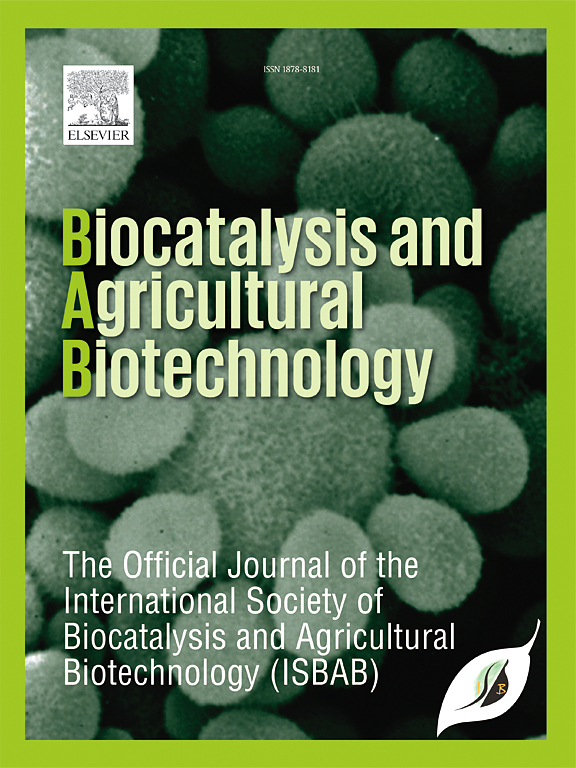Bioprotective microorganisms as antifungal and mycotoxin-degrading agents in food animals production
IF 3.4
Q2 BIOTECHNOLOGY & APPLIED MICROBIOLOGY
引用次数: 0
Abstract
Global meat production reached 357.39 million tons in 2021, with mycotoxin contamination, particularly zearalenone (ZEA) and fumonisin B1 (FB1), posing a major challenge due to their resistance to conventional preservation methods. These toxins negatively impact animal health, productivity, and food safety, requiring innovative control strategies. Alternative approaches, such as bioprotective microorganisms, may contribute to mycotoxin degradation and fungal control in the animal production chain. This study evaluated 23 bacterial and yeast strains for their ability to degrade ZEA and FB1 and inhibit mycotoxigenic fungi. Four bacterial strains effectively degraded ZEA: Bacillus amyloliquefaciens subsp. plantarum MLB3, Bacillus subtilis MLB2, Bacillus velezensis CL197, and Streptomyces griseus CECT 3276, though none achieved satisfactory FB1 degradation. The bacteria and their metabolites were effective in inhibiting fungal growth in both solid and liquid culture media, and simulated swine and poultry digestion demonstrated complete ZEA degradation, forming low-toxicity conjugates. These results suggest that selected bacterial strains could be applied in animal production to mitigate mycotoxin contamination, reduce fungal proliferation, and enhance food safety. The use of bioprotective bacteria represents a promising biotechnological approach to safeguarding both animal and human health while improving the quality and safety of animal-derived food products.
在食用动物生产中作为抗真菌和真菌毒素降解剂的生物保护微生物
2021年,全球肉类产量达到3.5739亿吨,霉菌毒素污染,特别是玉米赤霉烯酮(ZEA)和伏马菌素B1 (FB1),由于它们对传统保存方法的抗性,构成了重大挑战。这些毒素对动物健康、生产力和食品安全产生负面影响,需要创新的控制策略。替代方法,如生物保护性微生物,可能有助于真菌毒素降解和动物生产链中的真菌控制。本研究评估了23种细菌和酵母菌株降解ZEA和FB1以及抑制真菌毒素生成真菌的能力。四株细菌能有效降解ZEA:解淀粉芽孢杆菌亚种。植物芽孢杆菌MLB3、枯草芽孢杆菌MLB2、velezensis芽孢杆菌CL197和灰色链霉菌CECT 3276,但都没有达到令人满意的FB1降解。细菌及其代谢物在固体和液体培养基中均能有效抑制真菌生长,模拟猪和家禽消化显示ZEA完全降解,形成低毒偶联物。这些结果表明,所选菌株可用于动物生产,以减轻霉菌毒素污染,减少真菌增殖,提高食品安全性。使用生物保护细菌是一种很有前途的生物技术方法,既能保护动物和人类健康,又能提高动物源性食品的质量和安全性。
本文章由计算机程序翻译,如有差异,请以英文原文为准。
求助全文
约1分钟内获得全文
求助全文
来源期刊

Biocatalysis and agricultural biotechnology
Agricultural and Biological Sciences-Agronomy and Crop Science
CiteScore
7.70
自引率
2.50%
发文量
308
审稿时长
48 days
期刊介绍:
Biocatalysis and Agricultural Biotechnology is the official journal of the International Society of Biocatalysis and Agricultural Biotechnology (ISBAB). The journal publishes high quality articles especially in the science and technology of biocatalysis, bioprocesses, agricultural biotechnology, biomedical biotechnology, and, if appropriate, from other related areas of biotechnology. The journal will publish peer-reviewed basic and applied research papers, authoritative reviews, and feature articles. The scope of the journal encompasses the research, industrial, and commercial aspects of biotechnology, including the areas of: biocatalysis; bioprocesses; food and agriculture; genetic engineering; molecular biology; healthcare and pharmaceuticals; biofuels; genomics; nanotechnology; environment and biodiversity; and bioremediation.
 求助内容:
求助内容: 应助结果提醒方式:
应助结果提醒方式:


